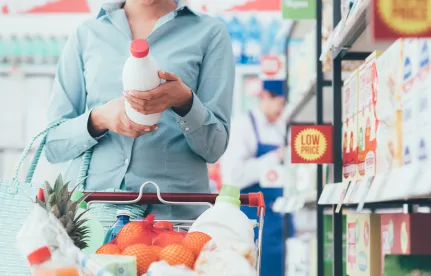On December 13, 2019, China’s National Health Commission (NHC) approved seven new food-contact substances and expanded use for nine food-contact substances.
The new substances approved for use in food-contact materials and articles, along with specifications and restrictions, are listed below.
-
Polycyclooctene (CAS no. 25267-51-0) is approved for use in ethylene-vinyl alcohol copolymer at a maximum use level of 8%. The single migration limit (SML) is 0.05 mg/kg for cyclooctene. Additional requirements are: 1) the thickness shall not exceed 100 100 µm; 2) the use temperature shall not exceed 100℃; and 3) it may not contact infant food and breast milk.
-
Formaldehyde, polymer with 3-methylphenol, butyl ether (CAS no. 61991-38-6) is approved for use in coatings and coating layers at a maximum use level of 12% (coating dry weight). The SML is 15 mg/kg for formaldehyde. Additional requirements are it may not contact food with an ethanol content above 50% and the use temperature may not exceed 127℃.
-
Copolymers of acrylamide, diallyldimethylammonium chloride, itaconic acid and propenoic acid (CAS no. 1802295-96-0) is approved for use in paper and paper board at a maximum use level of 1.5%, based on dry weight of finished paper. The SML is non-detect (ND) (ND=0.01 mg/kg) for acrylamide and 6 mg/kg for acrylic acid. An additional requirement is it may not contact infant food and breast milk.
-
Propenoic acid, polymer with butyl propenoate, compd. with N,N-diethylethanamine (CAS no. 27306-98-5) is approved for use in coatings and coating layers at a maximum use level of 1% in the coating formula. The SML is 6 mg/kg for acrylic acid.
-
Melamine, polymer with formaldehyde, isobutylated (CAS no. 68002-21-1) is approved for use in coatings and coating layers at a maximum use level of 6% (painting formula). The SML is 15 mg/kg for formaldehyde and 2.5 mg/kg for melamine. When this substance is used in food-contact materials and articles for infant formula, an additional SML of 1 mg/kg for melamine shall be applied.
-
5-Isobenzofurancarboxylic acid, 1,3-dihydro-1,3-dioxo-, polymer with 2-ethyl-2-(hydroxymethyl)-1,3-propanediol, 1,2-propanediol and 1,2,3-propanetriol (CAS no. 384330-10-3) is approved for use in coatings and coating layers. The SML is 5 mg/kg for trimellitic acid and 6 mg/kg for trimethylolpropane.
-
Benzoic acid, 2-hydroxy-, polymer with formaldehyde and 2,4-diamino-6-phenyl-1,3,5-triazine, ethylated methylated (CAS no. 196823-49-1) is approved for use in coatings and coating layers. The SML is 15 mg/kg for formaldehyde and 5 mg/kg for 2,4-diamino-6-phenyl-1,3,5-triazine. It may not contact food with an ethanol content above 8%.
Approval has been granted for expanded use of the substances listed below. The new use levels and other restrictions are included.
-
Microcrystalline wax (CAS no. 63231-60-7) may now be used in polystyrene (PS) at a maximum use level of 0.5%. Food-contact plastic materials and articles to which this substance is added may not contact foods that contain more than 50% alcohol and must comply with processing temperature and time limitations.
-
Fatty acids, C14-C18 and C16-C18-unsaturated (CAS no. 67701-06-8) may now be used in acrylonitrile-butadiene-styrene (ABS) at the necessary level required to achieve the desired effect.
-
Formaldehyde, phenol and p-tert-butylphenol polymer with n-butanol (CAS no. 2215936-67-5) may now be used in coatings and coating layers at a maximum use level of 9.5% (painting formula). The SML is 15 mg/kg for formaldehyde, 3 mg/kg for free phenol as phenol, and 0.05 mg/kg for P-tert-butylphenol.
-
Formaldehyde, reaction products with butyl alcohol and phenol (CAS no. 96446-41-2) may now be used in coatings and coating layers at a maximum use level of 10.8% for painting formulas. The SML is 15 mg/kg for formaldehyde and 3 mg/kg for free phenol as phenol. The use temperature may not exceed 121℃.
-
1,3-Benzenedicarboxylic acid, polymer with 1,4-benzenedicarboxylic acid, decanedioic acid, 2,2-dimethyl-1,3-propanediol and 1,2-ethanediol (CAS no. 26353-05-9) may now be used in coatings and coating layers at a maximum use level of 85% (film dry weight). The SML is 5 mg/kg for 1,3-phthalic acid; 7.5 mg/kg for 1,4-phthalic acid; 0.05 mg/kg for 2,2-dimethyl-1,3-propanediol; and 30 mg/kg for ethylene glycol. The use temperature may not exceed 127℃. In addition, the content of 2,2-dimethyl-1,3-propanediol in this substance may not exceed 30%.
-
1,3-benzenedicarboxylic acid, polymer with 1,4-benzenedicarboxylic acid, 1,4-cyclohexanedimethanol, 2,2-dimethyl-1,3-propanediol and 1,2-ethanediol (CAS no. 61960-52-9) may now be used in coatings and coating layers at a maximum use level of 35% (film dry weight). The SML is 5 mg/kg for 1,3-phthalic acid; 7.5 mg/kg for 1,4-phthalic acid; 0.05 mg/kg for 2,2-dimethyl-1,3-propanediol; and 30 mg/kg for ethylene glycol. The use temperature may not exceed 130℃. In addition, the content of 2,2-dimethyl-1,3-propanediol in this substance may not exceed 30%.
-
1,3-Benzenedicarboxylic acid, polymer with decanedioic acid, 1,4-dimethyl-1,4-benzenedicarboxylate, 2,2-dimethyl-1,3-propanediol and 1,2-ethanediol (CAS no. 61412-73-5) may now be used in coatings and coating layers at a maximum use level of 85% (film dry weight). The SML is 5 mg/kg for 1,3-phthalic acid; 7.5 mg/kg for 1,4-phthalic acid; 0.05 mg/kg for 2,2-dimethyl-1,3-propanediol; and 30 mg/kg for ethylene glycol. The use temperature may not exceed 127℃. In addition, the content of 2,2-dimethyl-1,3-propanediol in this substance may not exceed 30%.
-
Formaldehyde, polymer with methylphenol (CAS no. 9016-83-5) may now be used in coatings and coating layers at a maximum use level of 19% (painting formula). The SML is 15 mg/kg for formaldehyde and 3 mg/kg for free phenol as phenol.
-
Formaldehyde, polymer with 4,4'-(1-methylethylidene)bis[phenol], 3-methylphenol and 4-methylphenol, butylated (CAS no. 335637-88-2) may now be used in coatings and coating layers. The SML is 15 mg/kg for formaldehyde and 0.6 mg/kg for Bisphenol A. An additional restriction is it may not contact infant food and breast milk.



 />i
/>i

